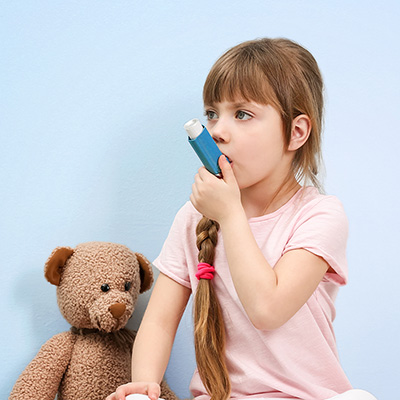Astmha in Children Under 5
Asthma is a common respiratory condition in early childhood but diagnosing it in children under 5 can be challenging. This is because many young children wheeze during viral infections, yet only a subset will go on to develop persistent or long-term asthma. Distinguishing transient wheeze from early asthma requires careful clinical evaluation over time.

Common Symptoms
Asthma symptoms in young children often present in subtle ways and may vary with infections, seasons, or exposure to irritants. Typical symptoms include:
- Recurrent or persistent coughing, especially at night, during or after physical activity, or with laughter or crying
- Wheezing or noisy breathing, especially with colds or exercise
- Rapid breathing or shortness of breath
- Difficulty feeding (in babies), or tiring quickly during play (in toddlers and preschoolers)
- Symptoms triggered by viral infections, cold air, allergens (dust, pets), or tobacco smoke
- Episodes that improve with asthma medication may be an important clue that asthma is present
Diagnosis
Diagnosing asthma in this age group requires careful observation and clinical judgement, as traditional lung function tests are often not feasible before age 5. Children under 5 may not yet have the coordination or ability to perform full lung function tests. However, several tools and approaches can support diagnosis:
- Detailed clinical history: frequency, pattern, and severity of symptoms, family history of asthma or allergy
- Assessment of response to trial treatment, e.g. inhaled corticosteroids or bronchodilators
- Monitoring over time for consistency of symptoms and response to triggers
- FeNO (exhaled nitric oxide) testing can be performed in some children from age 3 to support the diagnosis of eosinophilic airway inflammation
- Impulse oscillometry may be used from around age 3 as a child-friendly alternative to spirometry
- Spirometry may be attempted in children from age 4-5, depending on their cooperation and coordination
- Serum eosinophils
No single test confirms asthma in young children—diagnosis is based on a clinical pattern of symptoms and treatment response.
Management
The goal of asthma management in young children is to control symptoms, reduce the risk of severe attacks, and support normal growth and development. Management typically includes:

- Inhaled corticosteroids as a trial treatment if symptoms are severe or persistent or interfere with sleep, feeding, or activity
- Inhalers with a spacer and face mask to ensure effective delivery of medication. Older toddlers may progress to a spacer with mouthpiece
- Salbutamol (blue reliever inhaler) used for acute symptoms like wheezing or breathlessness
- Monitoring symptoms regularly and keeping a symptom diary can help identify patterns and triggers
- Avoiding environmental triggers, particularly passive smoke exposure, dust mites, mould, and pet dander
- A personalised asthma action plan, created with your healthcare team, outlines daily management and steps to take in an emergency
When to Refer
Children under 5 with frequent or severe symptoms, poor response to treatment, or diagnostic uncertainty may benefit from referral to a paediatric respiratory specialist. Consider referral if:
- There is an atypical presentation, such as persistent wet cough or failure to thrive
- The child requires courses of oral steroids
- There are concerns about underlying structural lung disease or aspiration
- There is significant parental anxiety, difficulty with adherence, or poor response to standard treatment
Located in London | Infants to young adults seen
Request a referral or book an appointment with Professor Gupta today.
